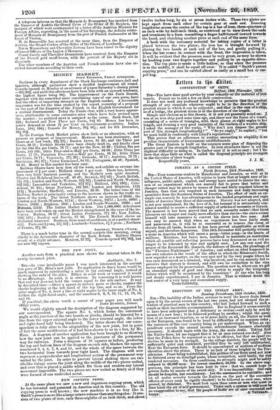IIEW COPYING- PRESS.
At the same place we saw a new and ingenious copying press, which he has invented and patented in America and in this country. The old copying press is well known ; the new machine is in no way like it. Smith's press is more like a large octavo volume than anything else. It con- sists of two plates of iron, each three-eighths of an inch thick, and about twelve inches long, by six or seven inches wide. These two plates are kept apart from each other by certain gear at each end. Running lengthwise across the centre of the top is a bar of iron, three-quarters of an inch wide by half-inch thick, so contrived as to turn down the ends and terminate in a form resembling a finger half-turned inward towards the hand, and clutching another piece at each end of the same form.
Alto& with the necessary material for taking copies of a letter is placed between the two plates; the iron bar is brought forward by placing the two hands at each end of the bar, and gently pulling it ; when the bar comes in contact with the front, the impression is taken. It will be evident that the pressure must be very great, es may be shown by hooking your two fingers together and pulling in an opposite direc- tion. The top plate is made a little hollow, so that when the pressure is in the middle, it shall be equal all over. 'rt is called " Smith's patent copying press;" and can be carried about as easily as a small box or car- pet-bag.


























 Previous page
Previous page